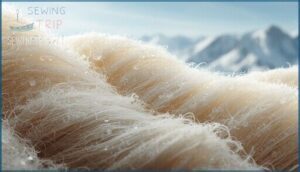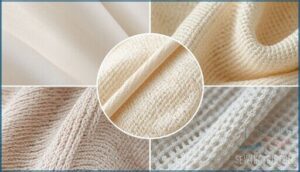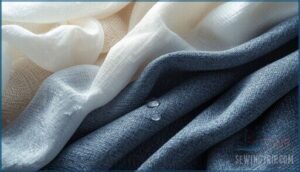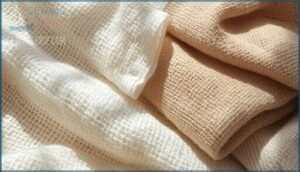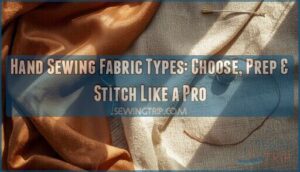This site is supported by our readers. We may earn a commission, at no cost to you, if you purchase through links.
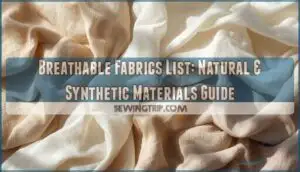
Cotton might absorb moisture like a champ, but polyester dries faster, and linen beats both for airflow. Each material on this breathable fabrics list brings specific strengths to the table, from merino wool’s temperature regulation to nylon’s durability in sportswear.
Understanding how natural and synthetic options compare helps you pick fabrics that keep you comfortable, whether you’re hiking, working, or just getting through a warm day.
Table Of Contents
Key Takeaways
- Natural fibers like cotton, linen, and merino wool excel at moisture absorption (cotton holds 27x its weight, wool absorbs 35% before feeling damp), while synthetic options like polyester and nylon dry faster—often in under two hours—making your fabric choice depend on whether you prioritize absorption or quick-drying performance.
- Fabric construction matters as much as material type: thinner fabrics under 150 GSM and open-knit weaves can boost air permeability by 25-30%, while moisture-wicking designs spread sweat across larger surface areas to speed evaporation and prevent that clammy feeling.
- Sustainability varies dramatically across fabrics—cotton uses 6,000 liters of water per kilogram and polyester sheds microfibers that account for 35% of ocean plastic pollution, while linen requires 60% less water than cotton and recycled synthetics cut energy use by 80%.
- Proper care extends fabric performance significantly: wash cotton and linen in cool water below 40°C, hand-wash silk in cold water, keep wool under 32°C to prevent shrinkage, and always skip fabric softeners on moisture-wicking materials since they clog fibers and block moisture transfer.
Natural Breathable Fabrics
Natural fabrics have been keeping people comfortable for centuries, and they’re still some of the best options when you need breathability. These materials come from plants and animals, and each one reacts to heat and moisture in its own way.
Let’s look at what makes cotton, linen, silk, and merino wool stand out.
Cotton Properties
Cotton fiber brings together science and comfort in a way few materials can match. You’ll find that cotton’s structure—about 90% cellulose with a twisted, ribbon-like shape—creates natural pathways for air to flow through the fabric. This breathable design helps moisture absorption reach impressive levels, holding up to 27 times its weight in water while keeping your skin dry. The thermal conductivity stays low at around 0.051-0.063 W/(m·K), so you stay cool without feeling clammy. Cotton also has high breathability, making it ideal for clothing.
- Moisture Absorption: Cotton wicks sweat at speeds up to 5.83 mm/s, spreading moisture quickly across the fabric surface
- Breathability Tests: Air permeability measures around 76 mm/s, allowing steady ventilation in hot weather
- Cotton Durability: The fibers actually get stronger when wet, maintaining their strength through 100+ wash cycles
Natural fibers like cotton prove their worth through real performance, not just marketing claims.
Linen Benefits
While cotton deals with moisture well, linen takes breathability to the next level with its unique flax-fiber structure. You’ll find linen absorbs up to 20% of its weight in moisture without feeling damp, thanks to its high moisture regain rate of 12%. The open weave promotes remarkable airflow, helping heat escape quickly in summer clothing.
Linen outperforms cotton by absorbing 20% of its weight in moisture while staying dry, thanks to its open weave that channels heat away faster
Beyond comfort, linen offers impressive strength—it’s about 30% stronger than cotton and lasts for decades when cared for properly. The sustainability impact stands out too, since flax needs 13 times less water than cotton and biodegrades naturally.
Linen even promotes regenerative properties in medical applications, fostering cell recovery through its antimicrobial composition. Linen’s ability to provide optimal body temperature makes it ideal for bedding.
Silk Characteristics
Unlike linen’s lightweight flax structure, silk fabric stands out with its unique protein composition—75–83% fibroin and 22–25% sericin—that creates exceptional breathability through natural thermal regulation. You’ll notice silk absorbs about 30% of its weight in moisture without feeling wet, thanks to its hydrophilic amino acids and hollow microscopic structure.
This natural fiber achieves impressive mechanical strength (3.5–4.0 cN/dtex) while remaining surprisingly sustainable, since silk production generates lower carbon emissions than cotton or polyester.
Why silk works for breathable clothing:
- Temperature control: The protein fibers naturally balance heat in both warm and cold conditions
- Moisture management: Absorbs humidity rapidly while releasing it efficiently to keep you dry
- Long-lasting wear: The triangular fiber cross-section provides flexibility and durability that outlasts many other fabrics
Merino Wool Advantages
While silk balances temperature through protein fibers, Merino wool takes thermal regulation even further—adapting efficiently from -5°C to 30°C through its unique air-trapping structure.
You’ll find this natural fiber absorbs up to 35% of its weight in moisture before feeling damp, wicking sweat away while maintaining insulation even when wet.
The odor resistance is striking: Merino retains 66% less smell than polyester and needs 50% fewer washes than cotton.
Fine fibers below 20 microns eliminate the itch of traditional wool, making these breathable fabrics comfortable for sensitive skin while delivering sustainability through biodegradable, renewable production.
Synthetic Breathable Fabrics
Synthetic fabrics have come a long way in breathability and performance. These engineered materials offer benefits you won’t find in natural fibers, like faster drying times and better durability.
Here’s what you need to know about the top synthetic options for staying cool and comfortable.
Polyester Features
Polyester stands out as a synthetic fiber powerhouse, built from petroleum-based polymers that deliver serious strength—over 60 cN/tex tensile strength keeps your gear intact through intense use. This synthetic fabric excels at moisture management through its hydrophobic structure, which naturally repels water and speeds up sweat evaporation. You’ll find these breathable fabrics dominating the market, with polyester blends holding 58.5% market share in 2025.
Here’s what makes polyester features essential for active lifestyles:
- Moisture-wicking synthetic fiber pulls perspiration away from skin efficiently
- Lightweight fiber composition creates comfortable, breathable shirts
- Quick-dry capabilities restore wearability within hours
- Sustainability advances through recycled polyester reducing emissions by 75%
Market growth continues as the spun polyester sector reaches USD 1.57 billion, reflecting strong demand for durable synthetic fabrics.
Nylon Uses
Athletic wear and outdoor gear rely on nylon because this synthetic fiber wicks moisture fast and dries quickly. You’ll see nylon dominating sportswear, hosiery, and swimwear—it held 38% of the global textile market by 2025 thanks to its tensile strength and stretch recovery. Apparel applications showcase nylon’s breathability through its hydrophobic structure that pulls sweat away from skin.
Beyond clothing, industrial engineering and automotive uses leverage nylon’s durability in vehicle parts, representing 36% of market revenue.
Sustainability impact improves as recycled nylon cuts energy use by 80% and emissions by 76%, though market growth continues pushing synthetic fabrics forward.
Rayon Applications
You’ll find rayon dominating apparel uses like summer dresses and blouses because it drapes beautifully and absorbs moisture better than cotton. This adaptable fabric appears across multiple sectors, from home textiles to medical applications, thanks to its cellulose-based breathability. Sustainable rayon alternatives now reduce chemical waste by 90% through closed-loop production systems.
- Apparel sector consumed over USD 6.5 billion in rayon during 2024, featuring printed shirts and wide-leg trousers
- Home textiles like bed linens and curtains benefit from rayon’s luxurious texture and anti-static properties
- Medical applications include sanitary products and surgical pads due to high absorbency and biodegradable characteristics
- Industrial rayon strengthens tire cords and nonwoven fabrics for filtration systems
Micro Modal Benefits
Micro Modal stands out because it absorbs 50% more moisture than cotton, keeping you drier during workouts. This breathable fabric combines natural fibers with sophisticated weaving techniques to deliver three key advantages:
- Moisture Absorption – wicks perspiration twice as fast as standard fabric
- Softness – stays silky through 50+ washes with minimal texture loss
- Durability – retains over 90% strength after repeated laundering
You’ll appreciate its thermal regulation properties that maintain cooler body temperatures while supporting sustainability through closed-loop production. The moisture-wicking structure speeds evaporation and resists odor buildup naturally.
Fabric Construction Matters
The way fabric is made changes how well air moves through it. You’ll notice big differences based on thickness, weave pattern, and how the fabric wicks sweat.
Let’s look at four construction features that affect breathability.
Thinner Materials
Thinner materials work like a screen door for your body. Lightweight fabrics under 150 grams per square meter boost air permeability dramatically, letting moisture vapor escape while maximizing thermal comfort.
Ultra-light fabrics like silk and mesh can move air up to ten times faster than heavier weaves.
When you’re choosing breathable fabrics, fabric weight matters—natural fibers and synthetic fibers both perform better when woven thin, creating fiber geometry that enhances airflow without sacrificing durability.
Open Knits
Open knits function like built-in air channels for your garments. Looser rib-knit structures with longer loops achieved air permeability increases from 161.8 to 246.8 cm³/cm²/s, proving that open weave designs create outstanding ventilation compared to tight constructions.
This structural optimization allows breathable fabrics to deliver remarkable airflow and moisture transfer while maintaining mechanical performance. Biodegradable knits using hemp blends even boost fabric construction sustainability without sacrificing cooling capabilities.
Moisture-Wicking Properties
Beyond structural airflow from open knits, moisture-wicking properties rely on fiber structure and wicking mechanisms to transport sweat away from your skin.
Synthetic fabrics like polyester deliver higher moisture management performance than natural fibers because they absorb less water yet spread it faster through capillary action.
This process reduces drying time by over 40% in high-performance blends, keeping your comfort levels steady during intense activity by preventing that clammy feeling against your skin.
Quick-Drying Technologies
Quick-drying technologies take moisture-wicking further by speeding up evaporation rates through hydrophobic coatings and engineered fabric structure. You’ll find sophisticated quick-dry fabrics now dry completely in under two hours, with some tests showing evaporation rates reaching 9.18 kg per square meter per hour.
Sustainable materials like recycled polyester have grown 25% in quick-drying apparel since 2020, meeting market trends for eco-friendly performance.
These moisture-wicking fabrics use dual-layer designs that reduce retained moisture by 82%, keeping you comfortable during workouts or travel without that clingy feeling against your skin.
Breathable Fabric Features
When you’re shopping for breathable fabrics, the right features can make all the difference in comfort and performance. Beyond the material itself, factors like fit design, environmental footprint, and fabric certifications help you make smarter choices.
Let’s look at what matters most when evaluating breathable fabrics for your needs.
Fit and Ventilation
How does garment airflow change when your clothes fit differently? Loose-fit clothing boosts convective airflow by up to 35% compared to tight garments in hot conditions. Your body’s natural cooling system works best when air can move freely between fabric and skin. Form-fitting activewear paired with moisture-wicking materials optimizes moisture transfer, enhancing evaporative cooling by about 20%. The key is matching fit to function—loose styles excel in casual summer wear, while semi-fitted designs with engineered ventilation zones perform better during exercise.
- Air vents strategically placed – Mesh panels or zippered openings in underarms and back regions deliver 10–25% better airflow and can drop skin temperature by up to 10°C.
- Body-mapped ventilation design – Fabric construction aligns breathable zones with your body’s major heat areas, improving heat dissipation by 15–18% during activity.
- Adjustable features for control – Roll-up sleeves and drawstrings let you fine-tune circulation, boosting comfort ratings by 30% in real-world testing.
Environmental Impact
Your clothing choices shape more than your comfort—they impact air and water quality around you. Cotton production releases 5.7 to 7.5 kg of CO₂ per kilogram of fiber and consumes roughly 6,000 liters of water per kilogram. Linen requires 60% less water, making it a greener choice. Synthetics shed microfibers that account for 35% of ocean plastic pollution. Choosing sustainable materials and eco-friendly textiles reduces your environmental footprint while supporting green production methods.
| Fabric Type | Environmental Impact |
|---|---|
| Cotton | High water use (6,000 L/kg), moderate carbon emissions |
| Linen | 60% less water than cotton, biodegradable |
| Polyester | Sheds microfibers, contributes to ocean pollution |
Sustainability Standards
Transparency builds trust when you’re shopping for breathable fabrics. Green certifications and eco labels help you identify sustainable materials backed by environmental audits and social compliance. GOTS requires at least 70% organic natural fibers with eco-friendly dyes and ethical production verified through annual inspections. OEKO-TEX issued over 57,000 certifications in 2024, testing both synthetic fabrics and natural options for chemical safety.
Look for these sustainable standards when choosing your next breathable textile:
- Bluesign approval confirms safe chemical processing and sustainable sourcing
- Fair Trade certification aids worker welfare and eco-friendly production
- Materials Matter Standard launches December 2025 for raw material transparency
- ISO 14001 tracks water reuse and emissions in textile manufacturing
- Higg Index tools measure environmental footprints across 45,000 global users
Chambray Fabric
Chambray fabric stands out among breathable fabrics thanks to its plain weave structure that creates natural ventilation channels through colored warp and white weft yarns.
The chambray composition generally features 100% cotton with thread counts between 150 and 500, giving you a lightweight fabric that weighs just 3 to 5 ounces per square yard.
You’ll enjoy moisture absorption rates of 7–9% by weight while the open weave delivers 25% better evaporative cooling than denser fabrics like twill or denim.
This fabric durability surprises many people—chambray withstands over 50 wash cycles with minimal color loss.
Choosing Best Fabric
Picking the right breathable fabric isn’t just about style—it’s about staying comfortable when things heat up. You’ll want to think about how the fabric manages sweat, how much it weighs, and whether it’ll hold up after washing.
Let’s look at what matters most when you’re choosing fabric that actually works for you.
Avoiding Sweating
When humidity climbs, your sweat absorption choices directly impact body temperature and comfort. Cotton can soak up 25 times its weight before saturation hits, while merino wool absorbs 30% without feeling wet—both offering enhanced odor resistance compared to synthetics.
Moisture-wicking fabrics spread perspiration across larger surface areas, speeding drying rates and preventing sweat stains. Polyester dries three times faster than untreated cotton, maintaining better thermal sensation during activity.
Strategic fabric selection keeps you cooler and drier without relying heavily on antiperspirants.
Fabric Weight
Think of fabric weight like insulation—it’s the difference between a summer breeze and a winter blanket. Lightweight fabrics under 150 GSM let air flow freely, making them your go-to for hot weather and intense workouts. Medium-weight options between 150 and 300 GSM balance durability with comfort for everyday wear. GSM impact on breathability is real: drop 100 GSM and you’ll gain about 25-30% more airflow.
Here’s what matters for climate suitability:
- Weight categories guide your choice—under 150 GSM for tropical climates, 150-300 GSM for moderate temps, over 350 GSM when cold hits.
Weave density tightens as weight increases, slowing drying speed by up to 18% per 100 GSM added.
Breathability Tests
Breathability tests reveal how well fabric manages heat and moisture under real conditions. You can start with simple checks at home—hold material to light for Air Permeability, or place it over steaming water to watch moisture vapor escape.
Professional labs use more precise methods like ISO 11092, which measures thermal resistance through a heated plate that simulates sweating. MVTR Testing (Moisture Vapor Transmission Rate) tracks how many grams of water vapor pass through fabric in 24 hours, with breathable materials scoring between 8,000 and 20,000.
Sweating Manikin systems take it further by mimicking human body heat and perspiration to evaluate Thermal Comfort during movement. These Breathability tests assign Ret values—fabrics under 6 are extremely breathable, while anything over 30 traps heat.
Understanding MVTR and Breathability performance helps you pick materials that actually keep you cool when it counts.
Fabric Care Instructions
Your breathable fabrics work best when you treat them right from the start. Cotton holds up with warm water and mild detergent at 1–2% concentration, while linen needs temps below 40°C to avoid stiffness. Silk demands hand washing in cold water, and wool thrives under 32°C to prevent shrinkage. Polyester stands up to machine washing at 60°C but sheds microfibers after ten cycles. Air drying beats tumble heat for durable performance across all materials.
- Washing Techniques: Cold water with gentle detergent protects natural fibers and Sustainable synthetics
- Drying Methods: Flat-dry wool and silk; tumble polyester on low to preserve structure
- Storage Solutions: Fold loosely in breathable bags to maintain airflow and prevent moisture buildup
Frequently Asked Questions (FAQs)
What fabric can you breathe through?
Your lungs could literally take a vacation if you tried breathing through pure silk—but thankfully, most fabrics let air pass right through. Cotton, linen, and bamboo feature natural pore sizes and weave density that allow excellent air permeability.
These breathable fabrics maintain fabric safety during sleep or workouts, unlike synthetic fabrics with tighter fiber types that restrict airflow.
What is the best fabric to avoid sweating?
Moisture-wicking fabrics like polyester and nylon excel at sweat absorption and quick drying.
For hot weather, merino wool and bamboo offer natural odor control while reducing skin irritation.
Your activity type determines the best breathable fabric list—choose materials that match your comfort level needs.
What fabrics work best for athletic wear?
For high-intensity activities, polyester and nylon shine with their impressive moisture-wicking capabilities—pulling up to 90% of sweat away from your skin. These quick-dry fabrics keep you comfortable during tough workouts.
Merino wool offers natural odor control and temperature regulation, making it ideal for multi-day wear in activewear.
How do breathable fabrics prevent body odor?
You know bacteria thrive on moisture, not sweat alone. Breathable fabric properties let air move through, speeding up evaporation so your skin stays drier.
That cuts bacterial growth, reducing body odor before it starts.
Which fabrics dry fastest after washing?
Ironically, quick-dry fabric built for speed actually holds onto moisture longer than you’d think. Synthetic fabrics like polyester and nylon lead the pack, drying in just one to two hours thanks to low water absorption and moisture-wicking properties.
Fiber type matters—natural fabrics like cotton take longer due to higher moisture retention, while weave density and thickness impact drying time considerably.
Modern drying technologies can cut drying time by 50%, making synthetic blends your fastest option after washing.
Do darker colors affect fabric breathability?
Color doesn’t change how breathable fabrics are—weave and fiber type do. Your black cotton breathes exactly like white cotton.
Darker colors absorb more heat and raise skin temperature, creating microclimate effects and thermal discomfort, but the fabric’s pore structure stays unchanged. Breathability depends on construction, not dye.
Whats the difference between moisture-wicking and breathable?
Breathable fabrics let heat and vapor escape through their pore size, while moisture-wicking fabrics use capillary action to pull sweat away from your skin.
Breathability focuses on airflow and temperature control, but wicking addresses moisture management by moving liquid outward for faster drying.
What fabrics work best for hot climates?
Picture stepping outside into blazing heat—your shirt clings within seconds. Climate fabric choice matters enormously for comfort and performance.
Lightweight cotton, linen, and merino wool lead among natural fabrics, absorbing moisture effectively while promoting sweat evaporation rates that keep you cool. Polyester and micro modal excel as synthetic fabrics, offering enhanced moisture-wicking and quick-drying material cooling properties.
Clothing breathability tests confirm open-weave hot weather fabrics outperform dense materials considerably.
How do you wash moisture-wicking clothes properly?
Use cold water, a gentle cycle, and a mild detergent designed for moisture-wicking fabrics. Skip fabric softeners entirely, as they clog fibers and block moisture transfer.
Air dry away from direct sunlight, or tumble dry on low heat if needed.
Can breathable fabrics prevent body odor buildup?
Yes, breathable fabrics help prevent body odor buildup by managing moisture and reducing bacterial growth. Moisture-wicking materials move sweat away from your skin, speeding up evaporation and creating an environment where odor-causing bacteria struggle to thrive.
Conclusion
Nobody wants to feel trapped in their own clothes. When you choose fabrics wisely, you’re not just picking materials—you’re securing comfort that lasts.
This breathable fabrics list gives you clear options, whether you lean toward cotton’s reliability, linen’s airflow, or polyester’s quick-dry performance.
Each fabric brings specific strengths to your wardrobe, from merino wool’s temperature control to nylon’s athletic durability. Match the material to your needs, and you’ll feel the difference every time you move.
- https://www.varthagaminternational.com/blogs/news/the-science-behind-fabric-breathability
- https://www.rei.com/learn/expert-advice/how-to-pick-the-most-breathable-fabrics.html
- https://meridianmillhouse.com/blogs/blog/types-of-fibers-natural-vs-synthetic
- https://bestcolorfulsocks.com/blogs/news/sustainable-blend-fabric-trends
- https://www.einpresswire.com/article/812158206/moisture-wicking-fabric-market-forecast-2025-2034-comprehensive-insights-on-market-size-growth-factors-trends




